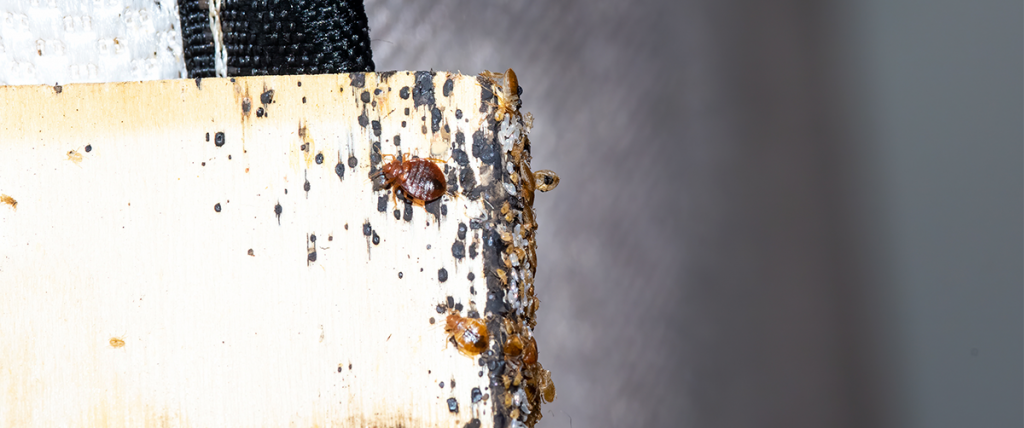5 Telltale Bed Bugs Signs
Do you suspect that you have bed bugs, but aren’t quite certain? This blog will give you 5 signs to look out for to give you clarity and provide information on what to do if you discover that you have an infestation.
Last year, we saw a bed bug epidemic sweep across the UK, with an increase of infestations rising by 65%. As these infestations are notoriously difficult to treat without professional assistance and with how rapidly they spread, it’s a problem that isn’t going away any time soon. Therefore, it’s important to know what bed bug signs to look out for and when it’s time to call in an expert’s help.

What Are Bed Bugs
Contrary to popular belief, it doesn’t mean that your property is unclean if you find that you have bed bugs. They can be found within any property and be easily transported into your home or business undetected.
Adult bed bugs are around 5-7mm in length. However, younger bed bugs and eggs can be extremely difficult to spot, as eggs can be as small as a grain of salt. These bugs can find their way into your properties by hitching a ride on items such as second-hand furniture, antique items, within luggage, or on people themselves. In fact, last year, public transport across bed bug hotspots in Europe is where a lot of problems came into play.
5 Signs To Check For To Assess If You Have Bed Bugs
1. Look For Bites On Your Body
At this time of year, bite marks are common due to the warmer (and damp) weather bringing out gnats and midges. It’s also the time of year when pets are more likely to have fleas if they haven’t been routinely treated, which will target areas such as wrists and ankles on humans. So, how do you assess if the bites are from bed bugs? Bed bug bites will typically be on areas such as your face, arms, and neck, which will appear red and swollen. You may also find bites in a row across your skin. These bites tend to not be painful, meaning they can sometimes go unnoticed.
If you have been bitten, follow NHS advice for treatment.
2. Assess Bedding For Signs Of Blood Spots
Bed bugs suck blood as they bite, so checking your sheets for signs of blood spots can be an indication that you have an infestation. Spotting is often found in a row formation. You’ll need to look up close, as these spots will be small in size and may just be a slight smudge.
3. Check For Black Spots Around The Room
Bed bugs tend to feed at night time and have common hiding spots during the day.
One of the greatest signs that you have a bed bug infestation is discovering tiny black or rust-coloured spots around the room, which are around 1 millimetre in size. Sorry to say, but these spots are actually their faecal excrement.
Here’s where to check for black spotting:
- Mattress seams and box springs
- Bed frames and headboards
- Carpets and underlay
- Timber floorboards
- Skirting boards
- Behind cracked or broken plaster and loose wallpaper
- Electrical sockets and fittings
- Wardrobes, drawers and cupboards
4. Do A Sniff Test
Bed Bugs leave an unpleasant odour from their glands. So, another indication that you have bed bug activity is a musty, sweet smell, similar to the smell of mould.
5. Look For Bed Bug Exoskeletons
Like other insects, bed bugs have their skeleton on the outside of their body. This means that they shed their skin in order for them to grow larger. Although these exoskeletons will be small and transparent, there should be ample evidence if you have an infestation.
Along with exoskeletons, you may even find dead bugs themselves in bedding, where they may have been squashed as you sleep.
How We Tackle Bed Bug Infestations
If all of these signs have added up to you believing you have a bed bug infestation, then it’s important to act fast as infestations spread extremely fast. Simply throwing items out won’t eliminate the problem, in fact, it may make issues worse and spread the infestation further.
Our bed bug removal treatment is time-intensive and will involve a thorough survey to identify levels and locations of infestation. For most properties, to ensure you gain 100% bed bug control, will require a minimum of three visits. This will entail every room in the property being treated to ensure a successful treatment due to the nature of the insect.
If you have an infestation, get in touch today with our experts for a free assessment.
